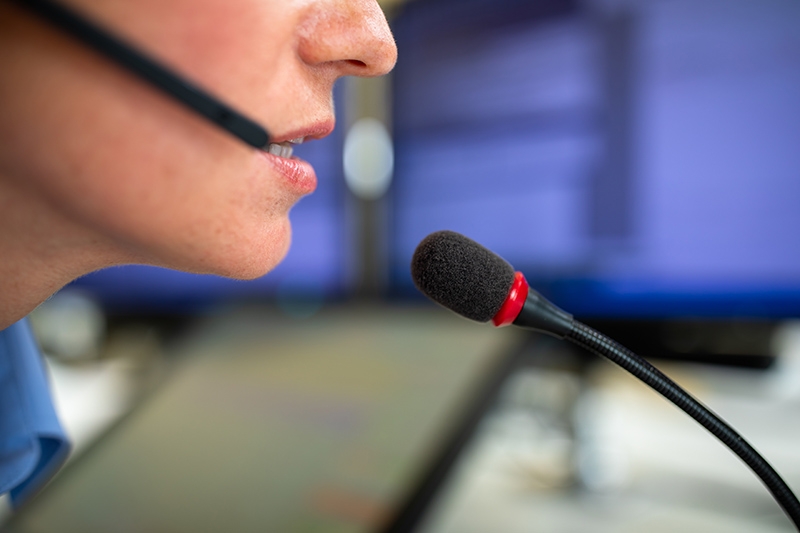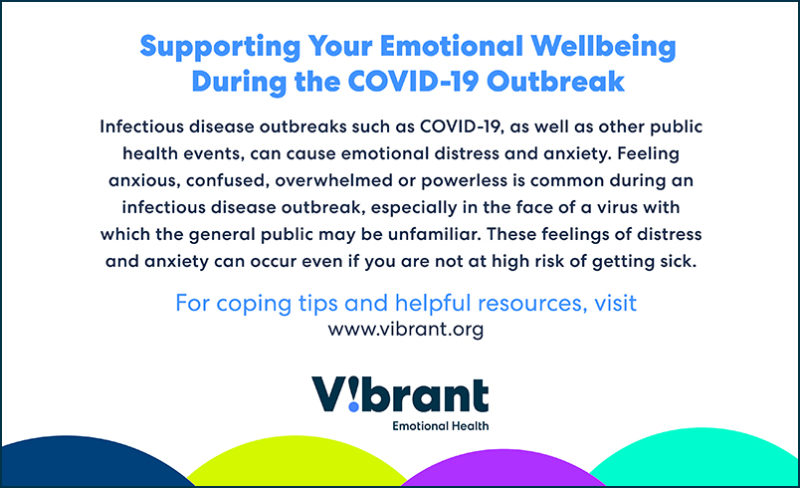The national Disaster Distress Helpline (DDH) was launched by Vibrant Emotional Health and the U.S. Substance Abuse and Mental Health Services Administration (SAMHSA) in 2012 to guarantee that everyone in the United States has access to immediate crisis counseling and support throughout any phase of a natural or human-caused disaster, including public health crises. Calls (1-800-985-5990) and texts (text TalkWithUs to 66746) are answered 24/7/365 by trained counselors from a network of independently-operated crisis centers located across the country who explore coping and available social supports, offer referrals to local resources for follow-up care, and who, most importantly, listen.

It’s through that listening that Vibrant and our network of crisis centers have learned from past disasters what emotional reactions we can anticipate in the weeks and months ahead as the Covid-19 pandemic continues to affect individuals, families, and communities across the U.S. From the tens of thousands of conversations our counselors have had over the past eight years, we know that many people will continue to be at risk for distress and other mental health concerns, while at the same time engaging in acts of heroism and adapting to aspects of life that may become a “new normal.”
These patterns correspond with physical, cognitive, emotional, behavioral, and spiritual reactions commonly experienced throughout the “phases” of any disaster, as cited by Raphael (1986 When disaster strikes: How individuals and communities cope with catastrophe. New York: Basic Books.), DeWolfe (2000 Training manual for mental health and human service workers in major disasters (2nd ed., HHS Publication No. ADM 90-538). Rockville, MD: U.S. Department of Health and Human Services, Substance), Halpern and Tramontin (2007 Disaster mental health theory and practice. Belmont, CA: Brooks/Cole CENGAGE Learning), Miller (2012 Psychosocial capacity building in response to disasters. New York: Columbia University Press) and other experts in disaster behavioral health.
These phases are: Pre-Impact or Pre-Disaster; Impact; Heroic and Honeymoon; Disillusionment; and Reconstruction.
The phases of disaster aren’t linear – they are marked by ups and downs, and some people may even find themselves taking “two steps forward, two back” at times. The phases also don’t occur on an exact timeline—people move forward on the path of recovery according to their own personal experiences with a disaster event.
Pre-Impact
The pre-impact or pre-disaster phase can last for days, such as when severe weather is forecasted, or mere minutes, such as when an active shooter is identified in the area. Calls and texts to the DDH during pre-impact commonly involve intense feelings of fear or anxiety of the “unknown.”
As the first reports of the novel Coronavirus Disease 2019 (“Covid-19”) began to emerge in China in December 2019 through to the first reported case in Washington in late February, DDH crisis centers reported no noticeable increase in related calls or texts. However, by early March, callers and texters began reporting a mounting sense of unease and a need for information related to Covid-19, particularly among people with underlying health concerns.
Impact
During the impact phase of most disasters, when the crisis is happening and threatening lives or property, the DDH typically isn’t receiving contacts from affected areas, since the priorities in that moment would be stabilization and safety. Those calls are going to 911. Calls and texts may start to come in from outside of the affected areas, from loved ones or others experiencing vicarious distress related to what they’re seeing and hearing in the media, or from people nearby who aren’t in immediate danger, but who are searching for information and resources because they’re feeling overwhelmed about a rapidly changing situation.
There is a common saying in disaster mental health “when a disaster occurs, no one is untouched by it,” though usually disasters are confined to a specific geographic area – a neighborhood, city, state, or region, such as with hurricanes. The first-level “circle of impact” includes people directly impacted by the event. They may have suffered losses or had some other high degree of exposure, resulting in an increased risk for distress or mental health concerns. The circle then expands outward from there to include people who were at or near the disaster, but weren’t directly impacted, and beyond.
Covid-19 is different. Every single person in the U.S. has been touched in some way by the pandemic, making the circle of impact quite large and at higher risk for distress: people who have been diagnosed with the disease, loved ones of people who are seriously ill or who have died, those who have become unemployed, people who are quarantined and socially isolated, “essential” front-line workers such as in healthcare, grocery/food retail, utilities, emergency responders, behavioral health workers, etc.
While infections are still occurring and distancing measures are still in effect, the vast majority of people in the U.S. are still experiencing the ‘impact’ phase of Covid-19.Contacts to the DDH during this period of time continue to be marked by fear and uncertainty, as well as distress related to financial strain, grappling with losses, interpersonal conflicts or rising tensions within households, isolation from limited access to social supports, stress from parenting or other caregiving responsibilities, and from essential workers worried about their physical and emotional health.
Heroic and Honeymoon
During the heroic phase, people from across the country have pulled together to support those most impacted by the pandemic via fundraisers, sewing masks, cheering healthcare and other frontline workers, and many more examples. This happens within cities with higher rates of infections and in areas that have seen zero infections. Concurrently, it’s common for the DDH to receive calls and texts during this phase from people searching for ways they can help—including volunteering directly with the DDH.
People who have been or are currently impacted are also compelled to engage in heroic behaviors, which can help them move forward on the path of recovery, mitigating against the distress they’re simultaneously experiencing. For them, engaging in helping can be a form of coping in and of itself.
The heroism behind these constructive actions builds toward the honeymoon stage, the peak at which people may individually and collectively feel optimistic and unified in the face of trauma and tragedy.
Disillusionment
Eventually and inevitably for most people affected by disaster, the impact of the heroism and honeymoon stage starts to lose its power to lift moods and cushion against distress. Resiliency is further tested and strained as financial support winds down or runs out, mental health and other services that were operationalized in the immediate aftermath of the event may start to wind down, and the media may shift attention to other newsworthy events. This can leave people still struggling emotionally to feel left behind.
DDH calls and texts see disillusionment after a disaster manifested as feelings of isolation, anger, frustration, hopelessness. Persistent or more serious mental health concerns, like depression, substance abuse, or anxiety, begin to surface as people start to grapple with losses and perhaps feel as if recovery isn’t possible.
Disillusionment often occurs several months after the initial impact of a disaster. Many people who have been personally affected by Covid-19 may be in the disillusionment phase now. Financial support may be limited or already used up and necessary physical distancing measures are starting to try people’s resolve and, in some places, community cohesion is starting to fray.
Following trends from past disasters, volume to the DDH typically starts to trend downward at some point during the disillusionment phase. Temporary distress reactions experienced from the impact stage through the initial stages of disillusionment start to diminish. At the same time, the surges in contacts from people seeking information and resources declines. as Communities “settle in” for long term recovery or reconstruction.
Reconstruction
For many people reconstruction after a disaster involves coming to terms with losses, adapting to a new normal, and overall working towards a new beginning or ‘reconstruction’. As with other disaster phases, there is no timeline for this stage of recovery. For some it might be a short period of time, while for others recovery may occur over months or even years. Long-term recovery can also be marked by setbacks, such as the occurrence of a new disaster or other traumatic event that can impede rebuilding. There are usually fewer remaining support services available specific to the disaster experienced, which can exacerbate a sense of loneliness for people still struggling.
Through the process of reconstruction, the optimal result of any person’s journey across these phases is post-traumatic growth, a process of integrating the “story” of one’s experiences from the disaster into their personal narrative. This includes lessons learned and new ways to cope to face future adversity.
As a 24/7/365, “never dormant, always available” disaster crisis and emotional support service, the DDH hears from people in the reconstruction stage who continue to struggle with difficult emotions years later, on milestone memorial dates when media tends to revisit the disaster or when commemorative community events occur. These may bring back painful memories, while also offering others a chance to acknowledge and honor any growth or rebuilding.
The question now is when will reconstruction from Covid-19 happen? For some who were seriously ill or who lost loved ones, that process may have already started. For others, who may still be in the impact or disillusionment stage, when distress or other mental health concerns are at their strongest and reconstruction seems far off, it’s important to keep looking forward. Friends, family and loved ones can help people look forward to this “final” stage, with the message that recovery is possible. Emotional health supports, like the DDH, are and will always be available. No matter what happens, you are not alone.
After any disaster, including the Covid-19 pandemic, we will find “strength after” together.
Christian Burgess, MSW, is Director of the Disaster Distress Helpline at Vibrant Emotional Health.




